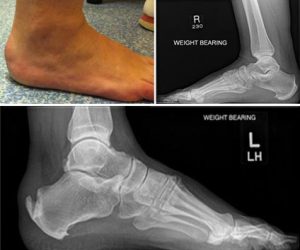Tendinopathy is a term used to describe an array of problems that can affect the Achilles tendon.
The two main regions of Achilles tendon that can become problematic, firstly near to where it joins heel bone (so called insertional) and secondly several centimeters above this (so called non insertional).
Why does it develop?
Often there is no specific reason, but a number of factors may make it more likely to develop:
e.g. Abnormal posture/ alignment of the foot ankle
Tight calf muscles
Haglund’s deformity (bony prominence in front of the Achilles insertion)
Inflammatory arthropathy
Excess body weight
It has been recently hypothesised that there may be a genetic tendency to develop it in some people.

What symptoms does it cause?
Pain in the affected area of the Achilles especially when walking or running up or down slopes. Sometimes people feel their ankle is weak or insecure due to the pain.
Swelling in the affected region of the Achilles, this may be tender and in the case of insertional Achilles tendinopathy this can lead to discomfort with shoe wear (see photo top, left). The swelling in insertional tendinopathy is often contributed to by calcification in the tendon just proximal to the insertion (See X-Ray bottom picture).
What treatment options are available?
The most appropriate treatment will depend on the type, exact location and extent of the tendinopathy, but some of them are briefly listed below:
i. Heel raise
A small raise in the heel of your shoe takes some tension off the Achilles
ii. Shoe adjustment
For insertional Achilles tendinopathy where there is a swelling over the heel it is important to wear ’soft countered’ shoes (the counter is the back of the shoe that lies against the heel). This will help reduce the irritation of this region.
iii. Pain killers/ Anti inflammatory tablets
These may help with any discomfort
iv. Physiotherpy
This treament usually settles a large percentage of cases of non insertional tendonpathy. See: Achilles Stetching Exercises.
v. Prolotherapy
This is a new type of treatment that involves a volume of fluid inserted around the Achilles to strip off the new blood vessels that have developed, which are thought possibly to be responsible for the development of pain.
vi. Lithotripsy
This is a newer form of treatment that involves shock waves being applied to the Achilles tendon, this is more appropriate for insertional rather than non insertional tendinopathy. This is performed in the outpatient clinic usually weekly for 3 to 5 weeks. See: Extra Corporeal Shock Wave Lithotripsy (ESWL).
vii. Surgery
This is of five main types:
1. Stripping of the tendon
This is the surgical equivalent of prolotherapy, it may also involve release of one of the nearby tendons which may help to ease the pain.
2. Debridement and repair of the tendon with or without tendon transfer
This involves the abnormal area of the tendon being removed and the remaining tendon being repaired. When the area of tendon involved is at the insertion the tendon may need to be repaired to the bone using suture anchors. In certain circumstances the remaining tendon is reinforced, by transferring another tendon into the heel bone. The tendon transferred is usually one of the two tendons that bend the big toe, however as the tendon that bends the smaller toes has a link to the big toe tendon in the foot the big toe still bends after the surgery. See: Achilles Tendon Debridement
3. Calcaneal osteotomy
Sometimes it is more appropriate to reset the heel bone to take some of the tension off the Achilles
4. Haglund’s excision
If the main problem is an area of prominent bone just in front of the Achilles (see insertional X-Ray, top, right) then this can be removed alone, sometimes this can be done using a keyhole technique.
The most appropriate treatment will be discussed with you by your specialist.
